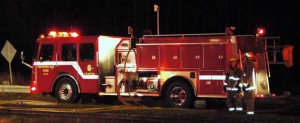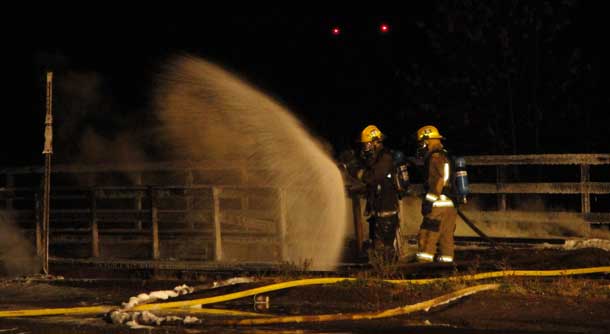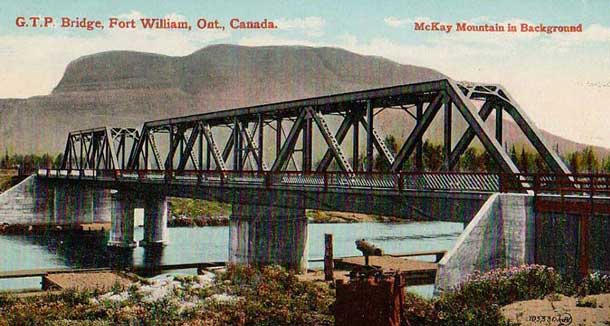
THUNDER BAY – OPINION – On October 29, 2013, the James Street bridge crossing the Kaministiquia River, which links Fort William First Nation with the City of Thunder Bay, caught fire. While the local media is tracking the criminal element of the fire, and while the politicians are promising to get to the bottom of what happened, there’s another story here that is going un-reported. As the bridge burned, social media lit up with white-settler racism directed at my reserve. It was a display of what most Canadians don’t like to admit, namely, that Canada is a racist place. Our communities – on both sides of the river – need to address the acts of hate speech posted online last night if we are to have a informed dialogue about what it means to live together in Anishinaabeg Aki, or Anishinaabeg territory.
What is it about catastrophe that makes white people feel they can release racist attacks on Indigenous communities, in moments when they’re most weak nonetheless? The white settler consciousness is teeming with fear of Indigenous peoples to the point that its undercurrents spill out when communities like mine find themselves in an emergency. This fear is based in a deep seated recognition that, yes, white people have stolen the land and that, therefore, seeing Indigenous peoples reminds them – if only subconsciously – that their privilege in Anishinaabe Aki is built on (failed) attempts at historical cultural and physical genocide. This fear comes out as hatred: every single online news story about Indigenous peoples in this country is trailed by a scorched path of racist “free speech” vitriol. Canada has a racism epidemic, and it is easily traced in the comments section.
And it spilled out again last night. The Thunder Bay Twitter community lit up with racism like a Christmas tree once news spread that the main bridge into Fort William First Nation was on fire. But what differentiated the social media KKK parade was that, unlike online news sites, the majority of posts came from young people. Consider these posts by @lucasgiardino and @paigeahola:
While these tweeters are clearly young, they nonetheless are well versed in how to demonize Indigenous communities. Their comments beg the question: my community should be permanently closed off because, clearly, Indians are a threat to ‘civilized’ society. Such comments ghettoize Fort William First Nation; we should be locked up like animals and left to burn to death in our own cage. Interestingly, this reflects the government’s original philosophies behind Indian reservations altogether: fence Indians in and make it nearly impossible for them to leave. The kids learn to tow the line well.
Maybe I’m being to hard on these young folks. Maybe they’re just mis-guided. Unfortunately, excusing their behaviour as individual mistakes only elides the fact that Canada is a racist society in a structural sense. These kids throw racism at my community because they’ve been taught by their parents and society at large that its okay to do so. In turn, parents are passing this belief on to each new generation, as @WeRMarshall15 so eloquently showed us just hours after the bridge caught fire:
If white people can admit that racism in Canada exists, Anishinaabeg already know that its not going to disappear over night. There have been too many broken promises. As George Lipsitz has said about racism in the US context, those white people invested in their privilege are not going to give it up easily. As last night’s James Street bridge fire shows, the ‘possessive investment in whiteness’ in Canada is a burning bridge that insulates white privilege from facing the changes that are needed.
That said, young Anishinaabeg folks have a different narrative. They are aware of how racism affects them, and how their peers perpetuate it. I asked some of the younger folks from my community what they thought about last night’s bridge fire. Some of them spoke about their relationship to the city, and how much it hurt to read what some of their peers were tweeting. They asked not to be named here, and I respect that because they’re the ones who have to share high school hallways with outspoken racists this week. One wrote:
What many people of Thunder Bay do not know is how cruel sparks of racism rising hurt Fort William First Nation peoples. It wasn’t long after the James Street swing bridge fire made it to the social media websites. So many comments stood out, but one that one that hurt the most was some guy saying he should block the other entrances to the reserve to save the city. This is beyond cruel – we’ve done nothing to provoke his threats.
Another contextualized last night’s racist comments more generally:
I find that the people of Thunder Bay always have something crude to say about Aboriginal people. While attending school I constantly have my ears open to the comments referring to Aboriginal peoples as “drunk, low life indians”. Why do you think that some of my people end up taking that road? What is easier – standing up to the racist comments or standing out of the way of them only to let it eat you from the inside out? We lose either way. My people are never going to find hope in the toxic [racist] environment we are forced to live in.
Finally, a young woman from my community astutely connected the bridge comments to broader issues of safety many Indigenous women contend with in settler society today:
The James Street swing bridge burning down not only showed a perfect example of the racism that has been going on for uncounted years, but also stirred up many emotions for the women in my community who feel unsafe in Thunder Bay. For many of us, the [James Street] bridge is the only way to get out of the city and back to a place where we feel a sense of safety, among our families on the reserve. To be ridiculed for losing that safety route only made me feel less safe [for the next time I’m in city].
Clearly, our youth know exactly whats going on.
Unlike the authors of the racist tweets and Facebook posts, the young people of Fort William First Nation spoke from their heart about improving our relationship with settler society. While the peddlers of white settler racism are telling us that we deserve every bad thing that happens to us, and that we should just do ourselves a favour and die in a ball of flames to lessen settler fear and guilt, the youth from my community are calling on them to stop wielding their privilege at the expense of Indigenous peoples lives and safety. Thunder Bay exists on Anishinaabeg land, and we should not be made to feel unwelcome in our own territory. Most importantly, the youth from my community point to the fact that Anishinaabeg are not leaving any time soon, and so settlers better get used to it.
Damien Lee











